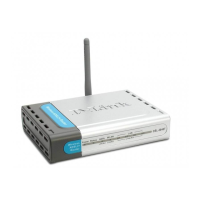DSL-2640T ADSL 2+ Router User Guide
44
ATM Settings - Traffic Shaping
The ATM settings in the WAN Settings windows for the different connection types can be used to adjust QoS
parameters for ADSL clients. This may not be available to all ADSL accounts.
ATM Settings for WAN connection
The table below provides a description of the ATM settings for traffic shaping.
ATM Parameters Description
Service Category
The ATM settings allow the user to adjust ATM Quality of Service (QoS) or traffic
parameters to suit specific traffic requirements. For applications or circumstances
where packet loss or packet delay is a concern, ATM QoS can be adjusted to
minimize problems. For most accounts, it will not be necessary to change these
settings. Altering QoS settings can adversely affect performance of some commonly
used Internet applications.
If you plan to change QoS or traffic parameters, contact your ISP or network
services provider for information on what types of adjustment are available or
possible for your account. Your ISP may not support the class of service you want
to use.
To adjust ATM QoS parameters, select one of the Service Categories listed here and
type in the PCR value in the entry field below. For the VBR service category, an
additional parameter (SCR) must also be defined.
UBR
– Unspecified Bit Rate, this is the default category used for general-purpose
Internet traffic where normal levels of packet loss and delay are acceptable. For
some applications or for multiple connection accounts, it may be desirable to
specify the PCR.
CBR
– Constant Bit Rate, usually used in circumstances where very low packet loss
and very low Cell Delay Variable (CDV) are desirable.
VBR-nt
– Real-time Variable Bit Rate. This models bursty traffic with specified peak
and sustainable rates. Please note that when VBR-rt is specified, both PCR and SCR
are required (by ATM standards).
VBR-nrt
– Non-real-time Variable Bit Rate, usually used when network traffic is
characterized by bursts of packets at variable intervals, and some moderate packet
loss and delay is acceptable. This category is typically used for audio and video
applications such as teleconferencing. The network must support QoS Class 2 to
use VBR-nrt.

